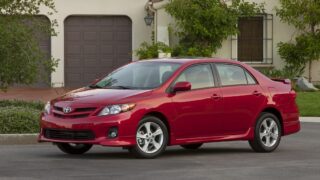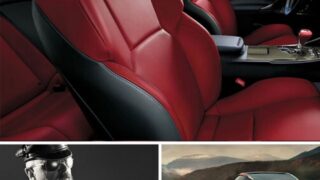Lexus IS Buyer’s Guide (1999-2020)
No matter which one you choose, the Lexus IS offers luxury, performance, and rock-solid reliability in any price range.
Lexus knew if it was serious about the luxury car market, it needed a competitor for the BMW 3 Series and Mercedes-Benz C-Class. Returning to the ES playbook, Lexus did its homework on the competition. Then it developed a small sedan based on an existing Toyota platform. To their credit, the engineers skipped over the Corolla and went to work on the Toyota Altezza, a JDM model with a rear-wheel drive platform and inline-six engine.
On paper, the first generation IS 300 looked like a Japanese BMW 3 Series. In addition to the inline-six and rear-wheel drive, the car’s dimensions lined up close to the BMW 328i. Specifications and performance lined up close as well. But that’s as far as the similarities go. The IS is distinctively Japanese, from its styling to how it drives. As a Lexus, it leans more towards the luxury side of the luxury/performance spectrum. But if you’re looking for performance, there are also a few dragons that will slay any number of sports cars.
Lexus IS Model History
Lexus produced three generations of IS models, including the current version. Over that time, the company made a sedan, wagon (first generation), and convertible (second generation). The engines included a 3.0-liter inline-six for the first generation IS 300, and V6 and V8 options for the second and third generation cars. Today, there is an IS for just about any budget or price range, but the first-generation models are the most scarce.
First Generation XE10 (1999-2005)
The first generation IS debuted with the 2JZ-GE 3.0-liter inline-six. Producing 215 horsepower, the IS could hit 60 mph in about 7.1 seconds. The IS offered a good mix of performance and comfort and could be equipped with a 5-speed or 6-speed manual in addition to the 5-speed automatic. A hatchback/wagon model followed the sedan but never really sold in volume in the U.S. Car magazines praised the IS for its composure, brakes, and build quality but complained about back seat room.
Unique to this model is the “chronograph” style instrument cluster. Styled to look like an expensive watch, with small gauges battery, temperature, and fuel economy embedded in the speedometer. The layout was original and allowed Lexus to present a lot of information in a small, pod-like instrument panel.
Of the three generations of IS models, the first one is the most unique. JDM fans like it because it stayed close to the home market Toyota Altezza. It’s also a popular car with the import tuner crowd. There is also plenty of aftermarket support, and the 2JZ-GE can be modified to produce serious power.
Second Generation XE20 (2006-2013)
The second generation IS matured into a more business-like sedan. Styling matched other Lexus offerings, looking as conservative as a button-down shirt. But underneath that shirt was a pair of new V6 engines. A toned 206-horsepower 2.5-liter V6 offered similar performance to the previous model. But the muscular 3.5-liter V6, with an extra 100 horsepower, became a seriously fast car. 0 to 60 mph times dropped into the low to the mid-five-second range, more than a match for the Infiniti G35 and BMW 330i. And if that wasn’t enough, the IS F model followed in 2007. Equipped with more aggressive bodywork and a 5.0-liter V8 producing a healthy 416 horsepower, the IS F was a second faster than the IS 350, hitting 60 mph in about 4.6 seconds. The top speed was a legitimate 170 mph backed by the feral sounds of the V8.
Buyers could choose a 6-speed manual transmission or a 6-speed automatic. All-wheel drive was available, and in 2008, Lexus launched a convertible version. Other Lexus goodies like upgraded interiors and a Mark Levinson stereo were also available. Critics remarked on the bland styling and thought that the car lacked the BMW’s composure. Buyers didn’t care. U.S. sales more than doubled the previous car.
Third Generation XE30 (2013-Current)
Some of the styling criticism must have stung because Lexus went bold with the next IS. Conservative styling gave way to a gaping maw, LED lights, and swoops and creases in the bodywork. The performance also took a step forward, with the IS 350 F Sport winning Car and Driver’s 2014 sport’s sedan comparo. The V6 engines remained, as did the 5.0 liter V8, and were joined by a hybrid model.
The interior received Lexus’ best effort. With styling inspired by the LFA, the instrument cluster combined a digital speedometer inside the tachometer framed by auxiliary gauges. The layout is distinctive with high-quality materials. Gone is any trace of wood, replaced by carbon fiber and metal trim. And with that wood, the IS discarded its “also ran” persona and moved to the head of the class.
What to Look For
The Lexus IS doesn’t have much of a history of trouble spots. According to Repair Pal, the most common problem across all years are problems with the evaporative emission (EVAP) system. A few people also reported problems with the power control module (PCM) but other than that, it’s basically wear and tear items.
Like all premium brands, parts are on the expensive side, but maintenance costs are relatively low, averaging about $600 per year. The only exception is the IS F and IS 500 models with the V8. It’s still a trouble-free car, but the V8 has higher maintenance costs and lower fuel economy.
What to Buy
It’s hard to go wrong with any of the IS models. The original IS 300 has a cult following, and many people view it as a modern classic. The second-gen cars have bottomed out on the depreciation curve and typically command the lowest prices. Finally, the third-gen is the most modern and the most complete package. It offers distinctive looks, great performance, and the typical Lexus reliability.
If you’re not buying a certified pre-owned car, the key is to find the best car in your price range. Look for cars listed by reputable dealers or from an owner with a comprehensive maintenance history. And no matter how good the car looks, take it to a knowledgeable mechanic for a pre-purchase inspection.
Photos: Lexus












